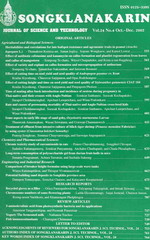ThaiScience
ThaiScience
SONGKLANAKARIN JOURNAL OF SCIENCE & TECHNOLOGY
Volume 41, No. 05, Month SEPTEMBER, Year 2019, Pages 959 - 965
Effect of a recombinant ribosomal protein l10a (rrpl10a) on mouse spermatogenesis
Kunwadee Palasin, Walaiporn Makkapan, Monwadee Wonglapsuwan, Wilaiwan Chotigeat
Abstract Download PDF
This study attempted to clarify RpL10a function in testis using mouse testis as a model. The histological method of mouse testis was used to determine the percentages of cell types in the spermatogenesis after being treated with a recombinant RpL10a protein (rRpL10a). The percentages of spermatid cells in the testis treated with 0.5, 1.0, 1.5, and 2.0 μM of rRpL10a protein were 40.78%, 49.65%, 45.03%, and 45.33%, respectively, while the untreated group was 21.72%. The spermatid cells of the experiment tissue were confirmed by WGA lectin histochemistry. Prm2 gene expression was moderately increased, whereas the expression of Rhau gene decreased in rRpL10a treated testes compared to the untreated testis. Furthermore, increased cell proliferation in the testes treated with 1.0 μM rRpL10a was revealed by an intense fluorescent signal of EdU (5-ethynyl-2′- deoxyuridine) staining. Altogether, the results indicated that the rRpL10a protein induced spermatogenesis in mice and may be applicable for in vitro spermatogenesis induction in the future.
Keywords
rRpL10a, spermatogenesis, testis, miceSONGKLANAKARIN JOURNAL OF SCIENCE & TECHNOLOGY
Published by : Prince of Songkla University
Contributions welcome at : http://rdo.psu.ac.th
